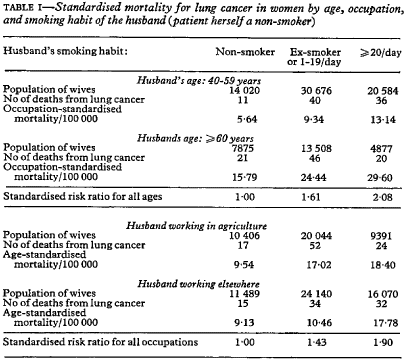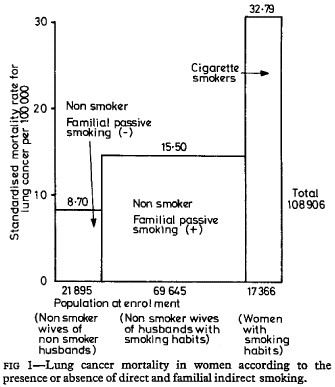PAPERS AND SHORT REPORTS
Non-smoking wives of heavy smokes have a higher risk of lung cancer: a study from Japan
Takeshi Hirayama
Abstract
In a study in 29 health centre districts in Japan 91 540 non-smoking wises aged 40 and above were followed up for 14 years (1966-79), and standardised mortality rates for lung cancer were assessed according to the smoking habits of their husbands. Wives of heavy smokers were found to have a higher risk of developing lung cancer and a dose-response relation was observed. The relation between the husband's smoking and the wife's risk of developing lung cancer showed a similar pattern when analysed by age and occupation of the husband. The risk was particulary great in agricultural families when the husbands were aged 40-50 at enrolment. The husband's smoking habit did not affect their wives' risk of dying from other disease such as stomach cancer, cervical cancer and ischaemic heart disease. The risk of developing emphysema and asthma seemed to be higher in non-smoking wives of heavy smokers but the effect was not statistically significant.
The husband's drinking habit seemed to have no effect on any causes of death in their wives, including lung cancer.
These results indicate the possible importance of passive or indirect smoking as one of the causal factors of lung cancer. They also appear to explain the long-standing riddle of why many women develop lung cancer athough they themselves are non-smokers. These results also cast doubt on the practice of assessing the relative risk of developing lung cancer in smokers by comparing them with non-smokers.
Introduction
The possible consequences to the health of non-smokers of long-term exposure to cigarette (passive smoking) should be studied thoroughly because the side-stream and second-hand smoke of cigarettes contain various toxic substances, including carcinogens. 1 2 The need for such a study increased by the report of small-airwais dysfunction in non-smokers chronically exposed to tobacco smoke.3
The effect of passive smoking on lung cancer was studied by following 91 540 non-smoking housewives aged 40 and above and measuring their risk of developing lung cancer according to the smoking habits of their husbands.
Methods
To study the consequences to health of such factors as cigarette smoking, alcohol drinking, ocupation, and marital status, a prospective population study has been in progress in 29 health centre districts in six prefectures in Japan since the autumn of 1965. In total 265 118 adults (122 261 men and 142 857 women) aged 40 years and over, 91-99% of the census population, were interviewed and followed by establishing a record linkage system between the risk-factor records, a residence list obtained by special yearly census, and death certificates.
Since the effect of direct smoking of cigarettes in this study has already been reported,4-7 my study focused on the effect of husband's smoking on the risk of lung cancer in their non-smoking wives. Such observation was possible since detailed questions about lifestyle, including smoking habits, were asked of husbands and wives independently at the start of this study. No subjective bias was therefore conceivable.
A total of 346 deaths from lung cancer in women were recorded during 14 years of follow-up (1966-79). Of these women 245 were married, and 174 of these were also non-smokers. These cases occurred among 91 540 non-smoking married women whose husbands' smoking habits were studied. The risk of lung cancer was carefully measured, taking into consideration possible confounding variables.
Results
Wives of heavy smokers were found to have a higher risk of developing lung cancer than wives of non-smokers and a statistically significant dose-response relationship was observed (Mantel-extension c test result being 3.299; two-tailed p = 0.00097). Age-occupation standardised annual mortality rates for lung cancer were 8.7/100 000 (32 out of 21 895) when husbands were non-smokers or occasional smokers, 14.0 (86 out of 44 184) when husbands were ex-smokers or daily smokers of 1-19 cigarettes, and 18-1 (56 out of 25 146) when husbands were daily smokers of 20 or more cigarettes. These figures gave risk ratios of 1.00, 1.61, and 2.08 respectively. A similar trend was observed in age and occupation groups of husbands (table I).

The relation between the husband's smoking habit and the wife's risk of developing lung cancer was particulary significant in agricultural families when the husband was aged 40-59 at enrolment (Mantel-extension chi being 2.597 or two-tailed p=0.0094); lung cancer risk ratios were 1.00, 3.17, and 4.57 when husbands were non-smokers or occasional smokers, ex-smokers or smokers of 1-19 cigarettes daily, and smokers of 20 or more cigarettes daily respectively (table II).

The husbands' smoking habits seemed to have no effect on their wives' risk of developing other major cancers of the stomach (n=716) and of the cervix (n=250) or ischaemic heart disease (n=406). The risk of developing emphysema and asthma seemed to be higher among the non-smoking wives of smokers, but the effect was not satistically significant (table III).

Other characteristics of the husbands, such as their alcohol drinking habits did not affect mortality from lung cancer in their wives. The relative risk ratios of death from lung cancer were 1.00, 1.13, and 1.18 (p=0.396) respectively when husbands were non-drinkers, occasional or rare drinkers, and daily drinkers. Similar results were found with other causes of death (table IV).

Finally, the effect of passive smoking was compared with the effect of direct smoking. The effect of passive smoking was around one-half to one-third that of direct smoking. The relative risk of developing lung cancer by passive smoking was about 1.8 compared with about 3.8 in direct smokers (fig 1).

Discussion
The possible effect of passive smoking was studied by following many non-smoking wives whose husbands had various smoking habits, and measuring their risk of developing lung cancer. Continued exposure to their husbands' smoking increased mortality from lung cancer in non-smokers up to twofold. The extent of the increase in the risk of developing cancer reached as high as 4.6 for non-smoking wives of agricultural workers aged 40-59 who smoked 20 or more cigarettes a day.
The fact that there was a stastitically significant relation (two-tailed p=0.00097) between the amount the husbands smoked and the mortality of their non-smoking wives from lung cancer suggests that these findings were not the result of chance. To determine whether such an effect was limited to lung cancer, similar studies were conducted with other causes of death. Although there seemed to be a relation between husbands' smoking habits and deaths from emphysema and asthma in their wives, the effect of passive smoking was strongest with lung cancer. Passive smoking did not seem to increase the risk of developing stomach cancer, cervical cancer, or ischaemic heart disease. We found that smoking was the only habit of the husbands to affect wives' mortality. The absence of an effect of husbands' drinking habits on mortality in their wives was shown as an example.
The most important confounding variables would have been urban factors. Similar observations were therefore made for agricultural families and for non-agricultural families, and a similar dose-response relation was observed in both groups. The effect of passive smoking was most striking in younger couples in agricultural families, relative risk reaching 4.6, probably because of the lesser extent of the exposure to passive smoking outside the family in the case of rural residents. That the rate for non-smoking wives with husbands who were heavy smokers in urban families was lower than that in rural families is puzzling but probably reflects a longer period of mutual contact of couples in rural families. In urban families some couples meet only for a short period in the day.
Finally, the effects of passive smoking were compared with the effects direct smoking. The results clearly indicated that the effect of passive smiking is about one-half to one-third that of direct smoking in therms of mortality ratio or relative risk. In therms of attributable risk, however, the effect of passive smoking on lung cancer in women must be much more important than that of direct smoking (fig 1), especially in countries such as Japan where 73% of men but only 15% of women smoke. Therefore, although the relative risk of indirect smoking was smaller than of the direct smoking, the absolute excess deaths from lung cancer due to passive smoking must be important because of the large size of the exposed group.
The age-adjusted mortality rates for lung cancer have been sharply increasing both for men and for women in Japan (fig 2). As only a fraction of Japanese women with lung cancer smoke cigarettes, the reasons why their mortality from lung cancer parallels that in men have been unclear. The present study appears to explain at least a part of this long-standing riddle.

This observation also questions the validity of the conventional method of assessing the relative risk of developing lung cancer in smokers by comparing them with non-smokers. This study shows that non-smokers are not a homogenous group and should be subdivided according to the extent of previous exposure to indirect or passive smoking.
This work was suported by Grants-in-Aid for cancer Research from the Ministry of Health and Welfare.
References
1 Brunnemann KD, Adams JD, Ho DPS, et al. The infuence of tobacco smoke on indoor atmospheres. II. Volatile and tobacco specific nitrosamines in main-aid sidestream smoke and their contribution to indoor pollution. In: Proceedings of the 4th Foint Conference on the Sensing of Environmental Pollutants. New Orleans 1977. Washington: American Chemical Society, 1978:876-80.
2 Brunnemann KD, Hoffmann D. Chemical studies on tobacco smoke LIX. Analysis of volatile nitrosamines in tobacco smoke and polluted indoor environments. In: Waler EA, Griciute L, Castegnaro M, eds. Environmental aspects of N-nitroso compounds. (IARC scientifics publications No 19) Lyons : WHO, 1978:343-56.
3 White RJ, Froeb FH. Small-airwais dysfunction in non-smokers chronically exposed to tobacco smoke. N Engl F Med 1980;302:720-3.
4 Hirayama T. Prospective studies on cancer epidemiology based on census population in Japan. In: Proceedings of XI International Cancer Congress. Florense. Cancer Epidemiology and Environmental Factors, 3. Amsterdam: Excerpta Medica, 1975:26-35.
5 Hirayama T. Epidemiology of lung cancer based on population studies. In: Clinical implications of air pollution research. Chicago: The American Medical Association, 1976:69-78.
6 Hirayama T. Smoking and cancer. A prospective study on cancer epidemiology based on census population in Japan. In: Proceedings of the 3rd World Conference on Smoking and Health 1975. Washington: Department of Health Education and Welfare, 1977:65-72. (DHEW Publication No (NIH) 77-1413.)
7 Hirayama T. Prospective studies on cancer epidemiology based on census population in Japan. In: Nieburgs HE, ed. Third International Symposium on Detection and Prevention of Cancer. Pt 1. Vol 1. New York: Marcel, Dekter, 1977:1139-48.
(Accepted 13 November 1980)
National Cancer Centre Research Institute, Tokyo
TAKESHI HIRAYAMA, MD, MPH, Chief of epidemiology division
